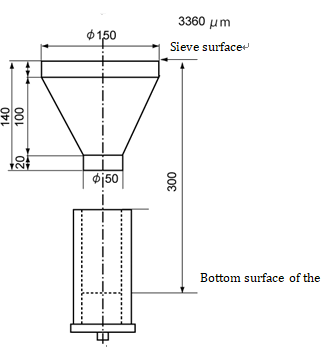Test Method: TJFS-107 Green sand compactability test method
1. Application
This applies to test method of green sand compactability measurement.
2. Definition
Compactability is defined as shrinkage ratio of green sand sampled under a certain condition when compressed with a force of a certain strength.
3. Instrument and apparatus
3.1 Test sand charger
The instrument in Fig.1 is used for charging sand into the test cylinder. A sieve of nominal mesh size of 3360μm is used in the charger.

3.2 Specimen rammer
The specimen rammer described in TJFS-101 (Preparation of standard green sand specimen) is used in the test. It may be replaced by a compression machine capable of giving a static pressure of 98N/cm2 to the sand in the cylinder.
3.3 Cylinder for forming specimens
The testing cylinder described in TJFS-101 (Preparation of standard green sand specimen) is used.
3.4 Bottom block for forming specimens
The bottom block described in TJFS-101 (Preparation of standard green sand specimen) is used.
3.5 Push out block
The Push out block described in TJFS-101 (Preparation of standard green sand specimen) is used.
3.6 Caliper
An M-type caliper is used.
3.7 Inspection
The instrument and apparatus used in the test are checked at an appropriate interval to maintain the necessary precision.
4. Testing procedure
4.1 Charging test sand
The cylinder is put on the bottom block and placed in the charger. The test sand is gently poured into the cylinder through the sieve. Pouring is stopped when sand overflows the cylinder. The excess sand above the cylinder top end is scraped off. Care should be exercised not to give vibration while the sand is poured and scraped. The sand after a test should not be reused for another test.
4.2 Ramming or compressing of the specimen
The cylinder containing the sand is removed from the charger, and placed in the specimen rammer. Then ramming is repeated three times, or static pressure of 98 N/cm2 is applied from above to the sand surface in the cylinder.
4.3 Measurement of the height of the specimen after ramming
The specimen in the cylinder is pushed out using the pushing rod, and the height is measured with a caliper.
4.4 Calculation of compactability
Compactability is calculated by the following equation.
\[C.B. = {(A-H) \over A} \times 100 \]
where
5. Expression
Compactability is expressed in %
6. Record
Results are calculated to the first decimal place. Tests are repeated two times or more from the same batch of sand and average value is calculated from results within ±5% of the standard deviation.

 NC-CBT-I
NC-CBT-I